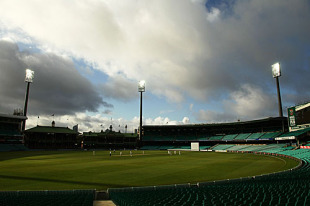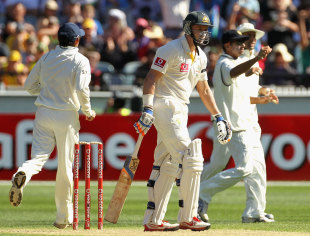India in Australia 2011-12
December 31, 2011
| |||
Related Links
Series/Tournaments: India tour of Australia
Teams: Australia
| |||
| |||
Related Links
News : India must learn to get tail out - Dhoni
Audio/Video: Dhoni's conservative approach a problem - Chappell
Players/Officials: MS Dhoni
Matches: Australia v India at Melbourne
Series/Tournaments: India tour of Australia
| |||

| |||
Related Links
News : Harris likely to be fit for Sydney Test, says Clarke
Series/Tournaments: India tour of Australia
| |||

| |||
Related Links
News : Cowan calls for uniformity in DRS use
Players/Officials: MS Dhoni
Matches: Australia v India at Melbourne
Series/Tournaments: India tour of Australia
| |||
| Australia 1st innings | R | M | B | 4s | 6s | SR | ||
| EJM Cowan | c †Dhoni b Ashwin | 68 | 285 | 177 | 7 | 0 | 38.41 | |
| DA Warner | c †Dhoni b Yadav | 37 | 54 | 49 | 4 | 1 | 75.51 | |
| SE Marsh | c Kohli b Yadav | 0 | 9 | 6 | 0 | 0 | 0.00 | |
| RT Ponting | c Laxman b Yadav | 62 | 145 | 94 | 6 | 0 | 65.95 | |
| MJ Clarke* | b Khan | 31 | 54 | 68 | 5 | 0 | 45.58 | |
| MEK Hussey | c †Dhoni b Khan | 0 | 1 | 1 | 0 | 0 | 0.00 | |
| BJ Haddin† | c Sehwag b Khan | 27 | 117 | 70 | 1 | 0 | 38.57 | |
| PM Siddle | c †Dhoni b Khan | 41 | 128 | 99 | 4 | 0 | 41.41 | |
| JL Pattinson | not out | 18 | 84 | 54 | 2 | 0 | 33.33 | |
| BW Hilfenhaus | c Kohli b Ashwin | 19 | 44 | 32 | 3 | 0 | 59.37 | |
| NM Lyon | b Ashwin | 6 | 15 | 11 | 1 | 0 | 54.54 | |
| Extras | (lb 21, w 2, nb 1) | 24 | ||||||
| Total | (all out; 110 overs) | 333 | (3.02 runs per over) | |||||
| Bowling | O | M | R | W | Econ | |||
| Z Khan | 31 | 6 | 77 | 4 | 2.48 | (1nb, 1w) | ||
| I Sharma | 24 | 7 | 48 | 0 | 2.00 | |||
| U Yadav | 26 | 5 | 106 | 3 | 4.07 | (1w) | ||
| R Ashwin | 29 | 3 | 81 | 3 | 2.79 |
| India 1st innings | R | M | B | 4s | 6s | SR | ||
| G Gambhir | c †Haddin b Hilfenhaus | 3 | 36 | 23 | 0 | 0 | 13.04 | |
| V Sehwag | b Pattinson | 67 | 125 | 83 | 7 | 0 | 80.72 | |
| R Dravid | b Hilfenhaus | 68 | 246 | 187 | 6 | 0 | 36.36 | |
| SR Tendulkar | b Siddle | 73 | 148 | 98 | 8 | 1 | 74.48 | |
| I Sharma | c †Haddin b Hilfenhaus | 11 | 102 | 69 | 0 | 0 | 15.94 | |
| VVS Laxman | c †Haddin b Siddle | 2 | 28 | 22 | 0 | 0 | 9.09 | |
| V Kohli | c †Haddin b Hilfenhaus | 11 | 27 | 21 | 1 | 0 | 52.38 | |
| MS Dhoni*† | c Hussey b Hilfenhaus | 6 | 11 | 8 | 0 | 0 | 75.00 | |
| R Ashwin | c †Haddin b Siddle | 31 | 55 | 35 | 3 | 1 | 88.57 | |
| Z Khan | b Pattinson | 4 | 6 | 6 | 1 | 0 | 66.66 | |
| U Yadav | not out | 2 | 20 | 16 | 0 | 0 | 12.50 | |
| Extras | (w 1, nb 3) | 4 | ||||||
| Total | (all out; 94.1 overs) | 282 | (2.99 runs per over) | |||||
| Bowling | O | M | R | W | Econ | |||
| JL Pattinson | 23 | 6 | 55 | 2 | 2.39 | (1w) | ||
| BW Hilfenhaus | 26 | 5 | 75 | 5 | 2.88 | (1nb) | ||
| PM Siddle | 21.1 | 2 | 63 | 3 | 2.97 | (2nb) | ||
| NM Lyon | 17 | 2 | 66 | 0 | 3.88 | |||
| MEK Hussey | 5 | 0 | 15 | 0 | 3.00 | |||
| DA Warner | 2 | 0 | 8 | 0 | 4.00 |
| Australia 2nd innings | R | M | B | 4s | 6s | SR | ||
| DA Warner | b Yadav | 5 | 28 | 27 | 0 | 0 | 18.51 | |
| EJM Cowan | lbw b Yadav | 8 | 32 | 17 | 1 | 0 | 47.05 | |
| SE Marsh | b Yadav | 3 | 22 | 11 | 0 | 0 | 27.27 | |
| RT Ponting | c Sehwag b Khan | 60 | 146 | 97 | 3 | 0 | 61.85 | |
| MJ Clarke* | b Sharma | 1 | 5 | 4 | 0 | 0 | 25.00 | |
| MEK Hussey | c †Dhoni b Khan | 89 | 219 | 151 | 9 | 0 | 58.94 | |
| BJ Haddin† | c Laxman b Khan | 6 | 8 | 14 | 0 | 0 | 42.85 | |
| PM Siddle | c †Dhoni b Yadav | 4 | 29 | 22 | 0 | 0 | 18.18 | |
| NM Lyon | lbw b Ashwin | 0 | 8 | 11 | 0 | 0 | 0.00 | |
| JL Pattinson | not out | 37 | 94 | 81 | 4 | 0 | 45.67 | |
| BW Hilfenhaus | c Laxman b Sharma | 14 | 43 | 29 | 2 | 0 | 48.27 | |
| Extras | (b 5, lb 2, w 1, nb 5) | 13 | ||||||
| Total | (all out; 76.3 overs) | 240 | (3.13 runs per over) | |||||
| Bowling | O | M | R | W | Econ | |||
| Z Khan | 20 | 4 | 53 | 3 | 2.65 | (3nb, 1w) | ||
| U Yadav | 20 | 4 | 70 | 4 | 3.50 | |||
| I Sharma | 12.3 | 0 | 43 | 2 | 3.44 | (2nb) | ||
| R Ashwin | 22 | 4 | 60 | 1 | 2.72 | |||
| V Sehwag | 2 | 0 | 7 | 0 | 3.50 |
| India 2nd innings (target: 292 runs) | R | M | B | 4s | 6s | SR | ||
| G Gambhir | c Ponting b Siddle | 13 | 54 | 46 | 1 | 0 | 28.26 | |
| V Sehwag | c Hussey b Hilfenhaus | 7 | 24 | 12 | 1 | 0 | 58.33 | |
| R Dravid | b Pattinson | 10 | 58 | 29 | 1 | 0 | 34.48 | |
| SR Tendulkar | c Hussey b Siddle | 32 | 71 | 46 | 4 | 0 | 69.56 | |
| VVS Laxman | c Cowan b Pattinson | 1 | 20 | 14 | 0 | 0 | 7.14 | |
| V Kohli | lbw b Hilfenhaus | 0 | 1 | 1 | 0 | 0 | 0.00 | |
| MS Dhoni*† | b Pattinson | 23 | 85 | 44 | 0 | 1 | 52.27 | |
| R Ashwin | c Cowan b Siddle | 30 | 36 | 35 | 5 | 0 | 85.71 | |
| Z Khan | c Cowan b Pattinson | 13 | 26 | 22 | 1 | 1 | 59.09 | |
| I Sharma | not out | 6 | 33 | 14 | 0 | 0 | 42.85 | |
| U Yadav | c Warner b Lyon | 21 | 26 | 25 | 2 | 1 | 84.00 | |
| Extras | (lb 10, w 2, nb 1) | 13 | ||||||
| Total | (all out; 47.5 overs) | 169 | (3.53 runs per over) | |||||
| Bowling | O | M | R | W | Econ | |||
| JL Pattinson | 15 | 2 | 53 | 4 | 3.53 | (1nb, 1w) | ||
| BW Hilfenhaus | 18 | 4 | 39 | 2 | 2.16 | (1w) | ||
| PM Siddle | 9 | 1 | 42 | 3 | 4.66 | |||
| NM Lyon | 5.5 | 0 | 25 | 1 | 4.28 |
| Match details | |||||||||
| Toss Australia, who chose to bat Series Australia led the 4-match series 1-0 | |||||||||
| Test debut EJM Cowan (Australia) Player of the match JL Pattinson (Australia) | |||||||||
| Umpires M Erasmus (South Africa) and IJ Gould (England) TV umpire PR Reiffel Match referee RS Madugalle (Sri Lanka) Reserve umpire AJ Barrow | |||||||||
|
| Match notes |
|